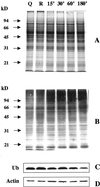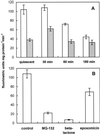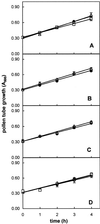Inhibition of proteasome activity strongly affects kiwifruit pollen germination. Involvement of the ubiquitin/proteasome pathway as a major regulator
- PMID: 11457965
- PMCID: PMC116471
- DOI: 10.1104/pp.126.3.1150
Inhibition of proteasome activity strongly affects kiwifruit pollen germination. Involvement of the ubiquitin/proteasome pathway as a major regulator
Abstract
The 26S proteasome is a multicatalytic complex that acts as primary protease of the ubiquitin-mediated proteolytic pathway in eukaryotes. We provide here the first evidence that the proteasome plays a key role in regulating pollen tube growth. Immunoblotting experiments revealed the presence of high levels of free ubiquitin and ubiquitin conjugates in rehydrated and germinating pollen of kiwifruit [Actinidia deliciosa var. deliciosa (A. Chev) C. F. Liang et A. R. Ferguson]. Proteasome activity, assayed fluorometrically, accompanied the progression of germination. Specific inhibitors of proteasome function such as benzyloxycarbonyl-leucinyl-leucinyl-leucinal (MG-132), clasto-lactacystin beta-lactone, and epoxomicin significantly decreased tube growth or altered tube morphology. High-molecular mass, ubiquitinated proteins accumulated in MG-132- and beta-lactone-treated pollen, indicating that proteasome function was effectively impaired. The inhibitors were also able to decrease in vitro proteasome activity in pollen extracts. Because MG-132 can inhibit calpains, as well as the proteasome, trans-epoxy succinyl-L-leucylamido-(4-guanidino) butane (E-64), an inhibitor of cysteine proteases, was investigated. Some reduction in tube growth rate was observed, but only at 80 microM E-64, and no abnormal tubes were produced. Furthermore, no inhibition of tube growth was observed when another inhibitor of cysteine proteases, leupeptin, or inhibitors of serine and aspartic proteases (phenylmethylsulfonyl fluoride and pepstatin) were used. Our results indicate that protein turnover during tube organization and elongation in kiwifruit pollen is important, and our results also implicate the ubiquitin/26S proteasome as the major proteolytic pathway involved.
Figures








Similar articles
-
Both Rb and E7 are regulated by the ubiquitin proteasome pathway in HPV-containing cervical tumor cells.Oncogene. 2001 Aug 2;20(34):4740-9. doi: 10.1038/sj.onc.1204655. Oncogene. 2001. PMID: 11498796
-
Roles of the ubiquitin/proteasome pathway in pollen tube growth with emphasis on MG132-induced alterations in ultrastructure, cytoskeleton, and cell wall components.Plant Physiol. 2006 Aug;141(4):1578-90. doi: 10.1104/pp.106.081703. Epub 2006 Jun 15. Plant Physiol. 2006. PMID: 16778013 Free PMC article.
-
Inhibition of ubiquitin-proteasome pathway activates a caspase-3-like protease and induces Bcl-2 cleavage in human M-07e leukaemic cells.Biochem J. 1999 May 15;340 ( Pt 1)(Pt 1):127-33. Biochem J. 1999. PMID: 10229667 Free PMC article.
-
Proteasome and myogenesis.Mol Biol Rep. 1997 Mar;24(1-2):77-81. doi: 10.1023/a:1006877214153. Mol Biol Rep. 1997. PMID: 9228285 Review.
-
Lactacystin, a proteasome inhibitor: discovery and its application in cell biology.Yakugaku Zasshi. 2000 Oct;120(10):935-49. doi: 10.1248/yakushi1947.120.10_935. Yakugaku Zasshi. 2000. PMID: 11082705 Review.
Cited by
-
Exogenous free ubiquitin enhances lily pollen tube adhesion to an in vitro stylar matrix and may facilitate endocytosis of SCA.Plant Physiol. 2006 Dec;142(4):1397-411. doi: 10.1104/pp.106.086801. Epub 2006 Sep 22. Plant Physiol. 2006. PMID: 16998086 Free PMC article.
-
Genome-scale analysis and comparison of gene expression profiles in developing and germinated pollen in Oryza sativa.BMC Genomics. 2010 May 28;11:338. doi: 10.1186/1471-2164-11-338. BMC Genomics. 2010. PMID: 20507633 Free PMC article.
-
The RPN1 subunit of the 26S proteasome in Arabidopsis is essential for embryogenesis.Plant Cell. 2005 Oct;17(10):2723-37. doi: 10.1105/tpc.105.034975. Epub 2005 Sep 16. Plant Cell. 2005. PMID: 16169895 Free PMC article.
-
Ricin B chain targeted to the endoplasmic reticulum of tobacco protoplasts is degraded by a CDC48- and vacuole-independent mechanism.J Biol Chem. 2008 Nov 28;283(48):33276-86. doi: 10.1074/jbc.M805222200. Epub 2008 Oct 2. J Biol Chem. 2008. PMID: 18832379 Free PMC article.
-
Different degree in proteasome malfunction has various effects on root growth possibly through preventing cell division and promoting autophagic vacuolization.PLoS One. 2012;7(9):e45673. doi: 10.1371/journal.pone.0045673. Epub 2012 Sep 21. PLoS One. 2012. PMID: 23029176 Free PMC article.
References
-
- Alché JD, Butowt R, Castro AJ, Rodriguez-Garcia MI. Ubiquitin and ubiquitin-conjugated proteins in the olive (Olea europea L.) pollen. Sex Plant Reprod. 2000;12:285–291.
-
- Bahrami AR, Gray JE. Conservation of proteasome structure and activity between plants and other eukaryotes. Biochem Soc Trans. 1998;26:395. - PubMed
-
- Becker F, Buschfeld E, Schell E, Bachmair A. Altered response to viral infection by tobacco plants perturbed in ubiquitin system. Plant J. 1993;3:875–881.
-
- Becker J, Kempf R, Jeblick W, Kauss H. Induction of competence for elicitation of defense responses in cucumber hypocotyls requires proteasome activity. Plant J. 2000;21:311–316. - PubMed
-
- Belknap WR, Garbarino JE. The role of ubiquitin in plant senescence and stress response. Trends Plant Sci. 1996;1:331–335.
MeSH terms
Substances
LinkOut - more resources
Full Text Sources
Other Literature Sources

